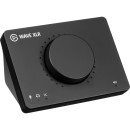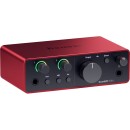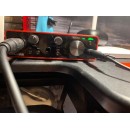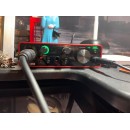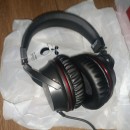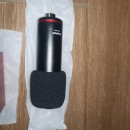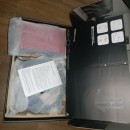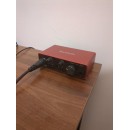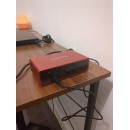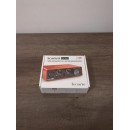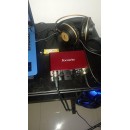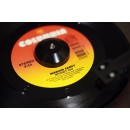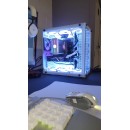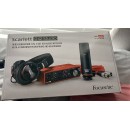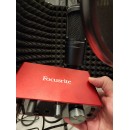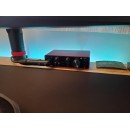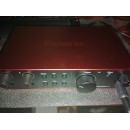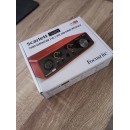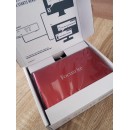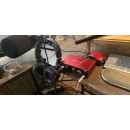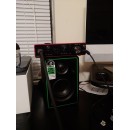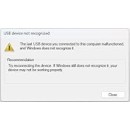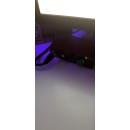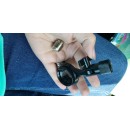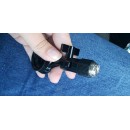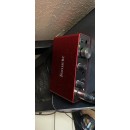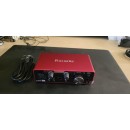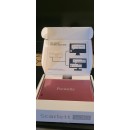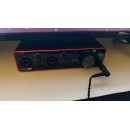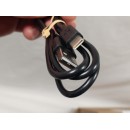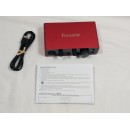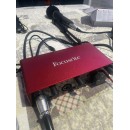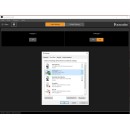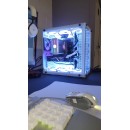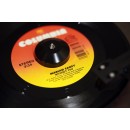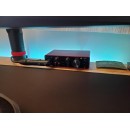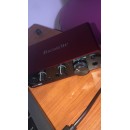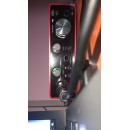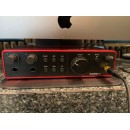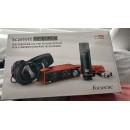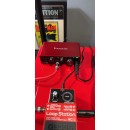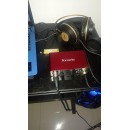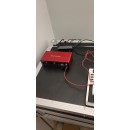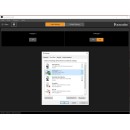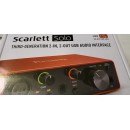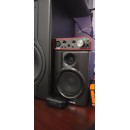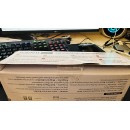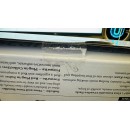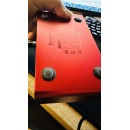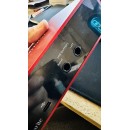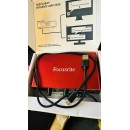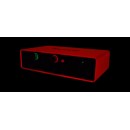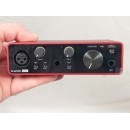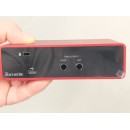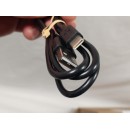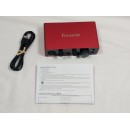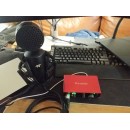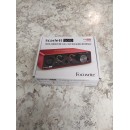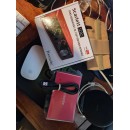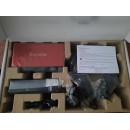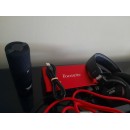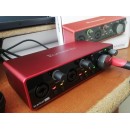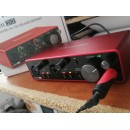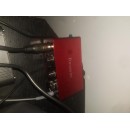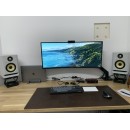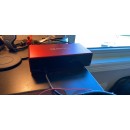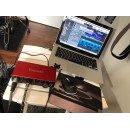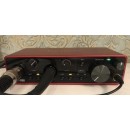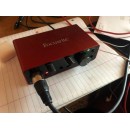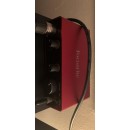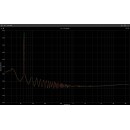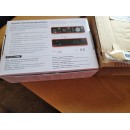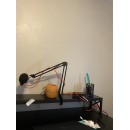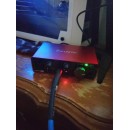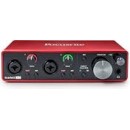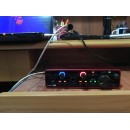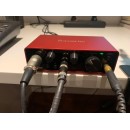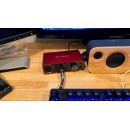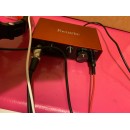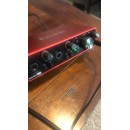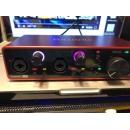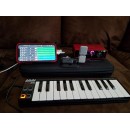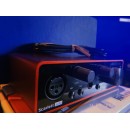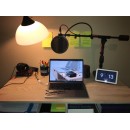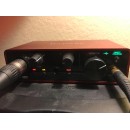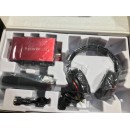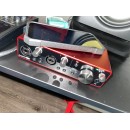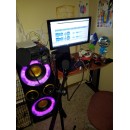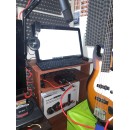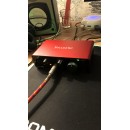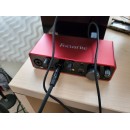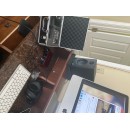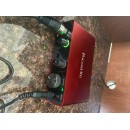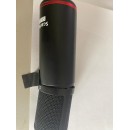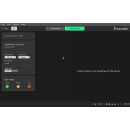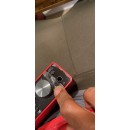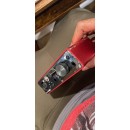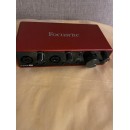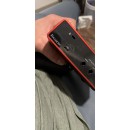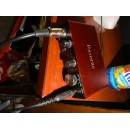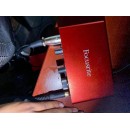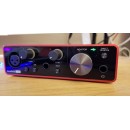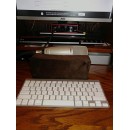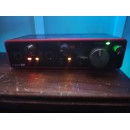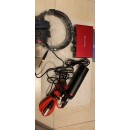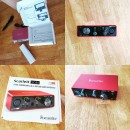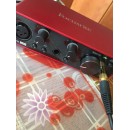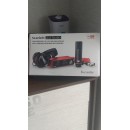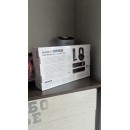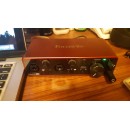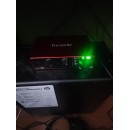Elgato Wave XLR vs Focusrite Scarlett Solo (4th Gen): Comprehensive Comparison
The Elgato Wave XLR USB-C Audio Interface and the Focusrite Scarlett Solo USB-C Audio Interface (4th Generation) are two popular choices for audio professionals and enthusiasts alike, each offering distinct features tailored to different needs. The Elgato Wave XLR is designed with streamers and content creators in mind, providing a compact and intuitive interface that excels in ease of use. It features a single XLR input, phantom power, and a capacitive mute button, making it ideal for live streaming scenarios where quick access to controls is essential. The interface integrates seamlessly with Elgato's Wave Link software, offering advanced audio routing capabilities that are beneficial for complex streaming setups.
On the other hand, the Focusrite Scarlett Solo (4th Generation) is renowned for its high-quality audio performance and reliability, making it a favorite among musicians and recording artists. It comes with a single XLR input for microphones and an additional line/instrument input, allowing for versatile recording options. The interface offers Focusrite’s acclaimed preamp quality, ensuring clear and professional sound capture. The Scarlett Solo also includes a range of software tools for music production, making it a comprehensive package for those looking to create studio-quality recordings.
Both interfaces utilize USB-C connectivity, ensuring fast data transfer and compatibility with modern devices. The Elgato Wave XLR stands out with its user-friendly interface and specialized features for streamers, such as the Clipguard technology that prevents audio distortion. Meanwhile, the Focusrite Scarlett Solo is praised for its robust build and superior sound quality, making it a reliable choice for musicians. Ultimately, the choice between these two interfaces depends on the user's specific needs, whether it's the simplicity and streaming-focused features of the Elgato Wave XLR or the versatile recording capabilities and superior audio fidelity offered by the Focusrite Scarlett Solo.
In this comprehensive comparison, we will delve into the specifications, pros, and cons of the Elgato Wave XLR and Focusrite Scarlett Solo USB-C audio interfaces. Our thorough examination will provide insights into their features, helping you make an informed decision on which audio interface best meets your needs.
In-Depth Specifications and Feature Analysis
| User Rating Based on Analysis of Reviews | |
|---|---|
|
Show More |
| Pros: | |
|---|---|
|
|
| Cons: | |
|---|---|
|
|
| Key Specs | |
|---|---|
| Channels of I/O | |
| Analog: 1 Input / 2 Outputs at 48/96 kHz |
Analog: 2 Inputs / 2 Outputs at 192 kHz |
| Maximum Sampling Rate | |
| 96 kHz / 24-Bit | 192 kHz / 24-Bit |
| Number of Microphone Inputs | |
| 1 Preamp | 1 |
| Analog Audio I/O | |
| 1x XLR 3-Pin Balanced Mic Input 1x 1/8" / 3.5 mm TRS Headphone Output |
1x XLR 3-Pin Balanced Mic Input 1x 1/4" TS Unbalanced Line/Hi-Z Input (Front Panel) 2x 1/4" TRS Balanced Monitor Output 1x 1/4" TRS Headphone Output (Front Panel) |
| Host Connection | |
| 1x USB-C | 1x USB-C |
| OS Compatibility | |
| Windows 10 |
macOS Windows |
| Power Requirements | |
| USB Bus Power | USB Bus Power, USB Power Adapter (Not Included) |
The Elgato Wave XLR USB-C Audio Interface features 1 input and 2 outputs operating at a maximum sampling rate of 96 kHz / 24-Bit. It is equipped with 1 microphone preamp and provides an XLR 3-Pin Balanced Mic Input along with a 1/8" / 3.5 mm TRS Headphone Output. The host connection utilizes USB-C and is compatible with Windows 10. Power is supplied via USB Bus Power.Show More
In contrast, the Focusrite Scarlett Solo USB-C Audio Interface (4th Generation) offers 2 inputs and 2 outputs with a higher maximum sampling rate of 192 kHz / 24-Bit. It also includes 1 microphone input, but adds an additional 1/4" TS Unbalanced Line/Hi-Z Input on the front panel. The Scarlett Solo features 2x 1/4" TRS Balanced Monitor Outputs and a 1/4" TRS Headphone Output on the front panel for monitoring. Like the Elgato, it connects via USB-C and is compatible with both macOS and Windows. Power is provided through USB Bus Power as well as an optional USB Power Adapter (not included).
When comparing the two, the Elgato Wave XLR is suitable for simpler setups with its single input and basic features, while the Focusrite Scarlett Solo offers more versatility with its dual input options and higher sampling rate. The Scarlett Solo's additional line input and output options make it a more robust choice for users who require greater connectivity and audio quality.
| General | |
|---|---|
| Channels of I/O | |
| Analog: 1 Input / 2 Outputs at 48/96 kHz |
Analog: 2 Inputs / 2 Outputs at 192 kHz |
| Maximum Sampling Rate | |
| 96 kHz / 24-Bit | 192 kHz / 24-Bit |
| Number of Microphone Inputs | |
| 1 Preamp | 1 |
| Built-In Microphone | |
| Input Level Adjustment | |
| 1x Knob | 2x Knob |
| Expansion Slots | |
The Elgato Wave XLR USB-C Audio Interface features a channel configuration of 1 Input / 2 Outputs at a maximum sampling rate of 96 kHz / 24-Bit. It is designed primarily for solo users, offering a single preamp for microphone input. The interface does not include a built-in microphone and allows for input level adjustment using a single knob. There are no expansion slots available, making it a straightforward and compact option for those who require basic audio interface capabilities.Show More
In contrast, the Focusrite Scarlett Solo USB-C Audio Interface (4th Generation) boasts a more versatile channel configuration of 2 Inputs / 2 Outputs, with a maximum sampling rate that reaches up to 192 kHz / 24-Bit. Similar to the Elgato, it has a single microphone input and lacks a built-in microphone. However, it offers dual input level adjustments with 2 Knobs, providing greater control over the input levels for users who may need to manage multiple sources. Like the Elgato, it does not come with expansion slots.
Overall, the choice between the Elgato Wave XLR and the Focusrite Scarlett Solo largely depends on the user's specific needs. The Elgato is ideal for those seeking a simple, user-friendly interface with decent audio quality, while the Focusrite offers higher sampling rates and more input control, making it better suited for users who require a bit more versatility in their recording setup.
| Signal Processing | |
|---|---|
| Gain/Trim Range | |
| 75 dB |
Mic/Line Inputs: Up to +69 dB Hi-Z Inputs: 62 dB |
The Elgato Wave XLR USB-C Audio Interface offers a gain/trim range of 75 dB, which is suitable for various recording scenarios. While it does not include a pad feature, it compensates with a built-in high-pass filter adjustable between 80 to 120 Hz. This allows users to eliminate unwanted low-frequency noise, enhancing overall audio clarity. Additionally, the interface features a mute option for the master output, providing flexibility during live sessions or recordings.Show More
In contrast, the Focusrite Scarlett Solo USB-C Audio Interface (4th Generation) boasts a gain/trim range of up to +69 dB for mic/line inputs and 62 dB for Hi-Z inputs. This range is slightly less than that of the Elgato, but it still accommodates a wide variety of sound sources effectively. The Scarlett Solo does not specify a high-pass filter feature, which may be a consideration for users looking to manage low-frequency noise directly from the interface.
In summary, while both interfaces cater to different needs, the Elgato Wave XLR excels with its high-pass filter and mute functionality, making it ideal for content creators focused on clean audio. The Focusrite Scarlett Solo, with its robust gain options, remains a reliable choice for musicians and podcasters who require versatility in handling various input types. Ultimately, the choice between the two will depend on the specific recording requirements and personal preferences of the user.
| Connectivity | |
|---|---|
| Analog Audio I/O | |
| 1x XLR 3-Pin Balanced Mic Input 1x 1/8" / 3.5 mm TRS Headphone Output |
1x XLR 3-Pin Balanced Mic Input 1x 1/4" TS Unbalanced Line/Hi-Z Input (Front Panel) 2x 1/4" TRS Balanced Monitor Output 1x 1/4" TRS Headphone Output (Front Panel) |
| Phantom Power | |
| 48 V, Selectable On/Off | 48 V, Selectable On/Off |
| Digital Audio I/O | |
| Host Connection | |
| 1x USB-C | 1x USB-C |
| Host Connection Protocol | |
| USB 3.0 / 3.1/3.2 Gen 1 | USB 2.0 |
| USB (Non-Host) | |
| Sync I/O | |
| Network I/O | |
| MIDI I/O | |
The Elgato Wave XLR USB-C Audio Interface features a straightforward design, offering 1x XLR 3-Pin Balanced Mic Input and 1x 1/8" / 3.5 mm TRS Headphone Output. It supports 48 V Phantom Power, which is selectable for on or off. This interface utilizes a USB-C connection with compatibility for USB 3.0 / 3.1/3.2 Gen 1 protocols, making it versatile for modern setups. However, it lacks any digital audio I/O, sync I/O, network I/O, or MIDI I/O capabilities, resulting in a more simplified audio interface aimed primarily at microphone input.Show More
On the other hand, the Focusrite Scarlett Solo USB-C Audio Interface (4th Generation) provides a more comprehensive input/output configuration. It includes 1x XLR 3-Pin Balanced Mic Input and an additional 1/4" TS Unbalanced Line/Hi-Z Input located on the front panel. This model also features 2x 1/4" TRS Balanced Monitor Outputs and a 1/4" TRS Headphone Output on the front panel. Similar to the Elgato Wave, it supports 48 V Phantom Power but operates over a USB-C connection with USB 2.0 protocol. Like the Elgato, it does not include digital audio I/O, sync I/O, network I/O, or MIDI I/O.
In summary, while the Elgato Wave XLR is focused on providing a simple and efficient microphone input solution, the Focusrite Scarlett Solo offers enhanced versatility with additional inputs and outputs, making it better suited for users who require more extensive audio routing options. Both interfaces support phantom power and USB-C connectivity, but the Scarlett Solo stands out with its broader range of analog I/O connections.
| Performance | |
|---|---|
| Frequency Response | |
| 20 Hz to 20 kHz |
XLR Mic Inputs: 20 Hz to 20 kHz ±0.06 dB 1/4" Line Inputs: 20 Hz to 20 kHz 0.05 dB 1/4" Hi-Z Inputs: 20 Hz to 20 kHz 0.15 dB |
| Maximum Input Level | |
| 10 V |
XLR Mic: 9.5 dBu 1/4" Line: 22 dBu 1/4" Hi-Z: 12 dBu |
| Headphone Output Power | |
| 1/8" / 3.5 mm: 77 mW |
1/4": 32 mW into 33 Ohms 22 mW into 300 Ohms |
| Dynamic Range | |
| 100 dB |
XLR Mic Inputs: 113 dBA 1/4" Line Inputs: 113 dBA 1/4" Hi-Z Inputs: 112 dBA 1/4" Line Outputs: 120 dB 1/4" Headphone: 112 dB (at 33 Ohms) 115 dB (at 300 Ohms) Digital A/D Converters: 120 dB Digital D/A Converters: 130 dBA |
The Elgato Wave XLR USB-C Audio Interface offers a frequency response of 20 Hz to 20 kHz, making it suitable for capturing a wide range of audio frequencies. It has a maximum input level of 10 V, which provides substantial headroom for various audio sources. The dynamic range of the Elgato Wave XLR is 100 dB, ensuring that both quiet and loud sounds are captured effectively without distortion. Additionally, the headphone output power is rated at 77 mW through a 1/8" / 3.5 mm jack, allowing for adequate monitoring capabilities.Show More
In contrast, the Focusrite Scarlett Solo USB-C Audio Interface (4th Generation) boasts a more detailed frequency response for its inputs, particularly with the XLR mic inputs, which have a frequency response of 20 Hz to 20 kHz ±0.06 dB. The maximum input levels vary, with the XLR mic at 9.5 dBu, 1/4" line at 22 dBu, and 1/4" Hi-Z at 12 dBu. This versatility means it can accommodate a variety of audio sources efficiently. The Scarlett Solo has a dynamic range of up to 113 dBA for its mic and line inputs, which is notably higher than the Elgato, providing excellent audio clarity and detail.
The headphone output power of the Focusrite Scarlett Solo is lower than that of the Elgato, rated at 32 mW into 33 Ohms and 22 mW into 300 Ohms, which may limit monitoring capability for high-impedance headphones. However, the Scarlett Solo compensates with a maximum output level of +16 dBu and a superior dynamic range of 120 dB for line outputs. Furthermore, the unit features a total harmonic distortion and noise (THD+N) rating of -100 dB for its mic inputs at minimum gain, indicating a clean signal path essential for professional recordings.
In summary, while both interfaces offer excellent audio capabilities, the Elgato Wave XLR shines with its higher headphone output power, while the Focusrite Scarlett Solo excels in dynamic range and versatility across multiple input types. Users should consider their specific needs—such as monitoring capabilities versus input versatility—when choosing between these two high-quality audio interfaces.
| Digital Audio | |
|---|---|
| Sample Rates | |
| 48 / 96 kHz | 44.1 / 48 / 88.2 / 96 / 176.4 / 192 kHz |
| Bit Depths | |
| 24-Bit | 24-Bit |
The Elgato Wave XLR USB-C Audio Interface is designed with simplicity and functionality in mind, offering a maximum sample rate of 96 kHz. This makes it suitable for various audio applications without the need for extensive sample rate conversion, as it does not support this feature. The interface operates at a 24-Bit bit depth, ensuring high-quality audio capture and playback.Show More
In contrast, the Focusrite Scarlett Solo USB-C Audio Interface (4th Generation) provides a more versatile range of sample rates, including 44.1, 48, 88.2, 96, 176.4, and 192 kHz. This flexibility allows users to choose the optimal sample rate for their specific recording needs. Like the Elgato, it also features a 24-Bit bit depth, contributing to excellent audio fidelity. Additionally, the Scarlett Solo uses an internal sync source, which can be beneficial in multi-device setups.
In summary, if you require a straightforward audio interface with a solid sample rate of 96 kHz and 24-Bit depth, the Elgato Wave XLR is a suitable choice. However, for those looking for a broader range of sample rates, up to 192 kHz, along with an internal sync source, the Focusrite Scarlett Solo (4th Generation) stands out as the more versatile option.
| Audio Storage & Playback |
|---|
| Compatibility | |
|---|---|
| OS Compatibility | |
| Windows 10 |
macOS Windows |
The Elgato Wave XLR USB-C Audio Interface is designed specifically for Windows 10 users, providing a seamless integration for those operating on this platform. However, it is important to note that an internet connection is required for software and driver downloads, which may be a consideration for users with limited connectivity. This focus on Windows compatibility makes it a solid choice for streamers and content creators who primarily use this operating system.Show More
In contrast, the Focusrite Scarlett Solo USB-C Audio Interface (4th Generation) offers broader compatibility, supporting both macOS and Windows operating systems. This versatility allows it to cater to a wider audience, including those who may want to switch between different platforms. Additionally, it is compatible with mobile devices, specifically iPadOS, making it a great option for users who wish to record on the go or utilize their iPads for audio production.
Overall, while the Elgato Wave XLR is tailored for Windows 10 users and emphasizes a straightforward setup process, the Focusrite Scarlett Solo stands out with its multi-platform support, including mobile compatibility. This makes the Focusrite a more flexible choice for users who require an interface that can adapt to various devices and operating systems.
| Power | |
|---|---|
| Power Requirements | |
| USB Bus Power | USB Bus Power, USB Power Adapter (Not Included) |
The Elgato Wave XLR USB-C Audio Interface operates solely on USB Bus Power, making it a convenient choice for those looking for a straightforward, portable solution. This feature allows users to connect the device directly to their computer without the need for additional power sources, enhancing its usability for on-the-go recording and streaming setups.Show More
In contrast, the Focusrite Scarlett Solo USB-C Audio Interface (4th Generation) also utilizes USB Bus Power, but provides the option of using a USB Power Adapter (not included) for users who may require a more stable power source. Its specifications mention an AC/DC Power Adapter requirement of 5 VDC at 900 mA and a power consumption of 4.5 W, which indicates that it can operate effectively with both bus power and an external adapter, providing added flexibility for different recording environments.
Overall, both interfaces are designed to meet the power needs of users, but the Elgato Wave XLR's reliance on USB Bus Power alone may appeal to those prioritizing simplicity and portability. On the other hand, the Focusrite Scarlett Solo's dual power options offer more versatility for users who might need the additional stability of an external power source in certain situations.
| Packaging Info | |
|---|---|
| Package Weight | |
| 1.68 lb | 1.305 lb |
| Box Dimensions (LxWxH) | |
| 7.6 x 6.1 x 3.9" | 7.2 x 6.1 x 2.5" |
The Elgato Wave XLR USB-C Audio Interface has a package weight of 1.68 lb and box dimensions of 7.6 x 6.1 x 3.9". This interface is designed to cater to content creators and streamers, offering features tailored for high-quality audio input and control. Its slightly larger size and weight may suggest a more robust build, which is ideal for studio setups requiring durability.Show More
In contrast, the Focusrite Scarlett Solo USB-C Audio Interface (4th Generation) is lighter, with a package weight of 1.305 lb and more compact box dimensions of 7.2 x 6.1 x 2.5". This makes it a more portable option, suitable for musicians and podcasters who require a lightweight interface for on-the-go recording. The smaller profile allows for easier integration into tight spaces, which can be a significant advantage for mobile setups.
Both interfaces are equipped with USB-C connectivity, ensuring modern compatibility and fast data transfer rates. However, their physical dimensions and weights indicate differing intended uses, with the Elgato Wave XLR leaning towards a more stationary setup, while the Focusrite Scarlett Solo is optimized for portability. Users should consider these specifications in relation to their specific audio needs and workspace constraints.
| Customer Images | |
|---|---|
| Videos | |
|---|---|
|
|
|
